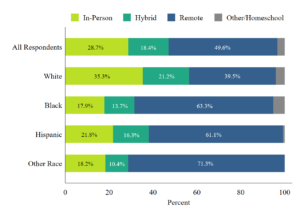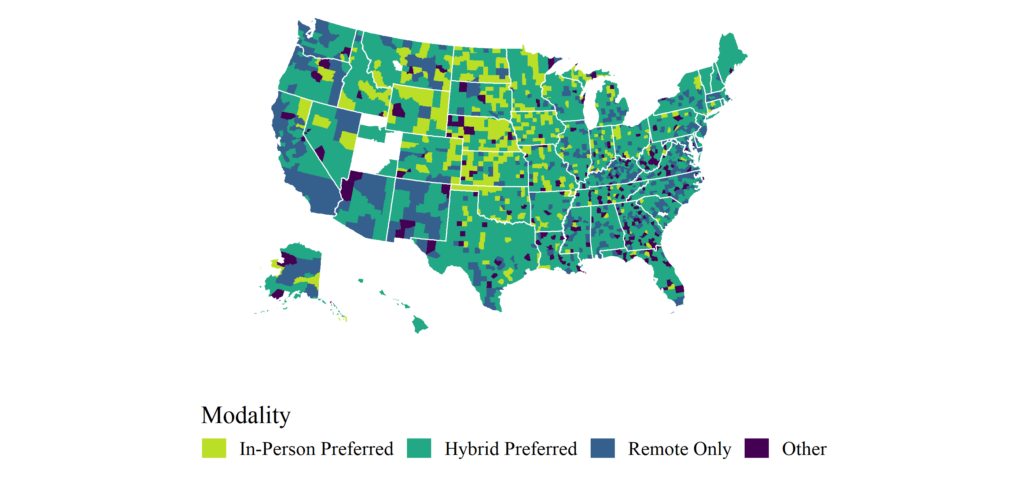A growing body of research and popular reporting shows significant racial differences in how children are attending school during the COVID-19 crisis, with white students more likely to attend school in person while Black and Hispanic students attend remotely at higher rates. Using data from the Understanding Coronavirus in America Tracking Survey (UCA), collected during the fall of 2020, we observe that nationally, a majority of families (68%) used some sort of remote learning (fully remote or hybrid models). However, large differences appear by race with 77% of Black and Hispanic parents using fully remote or hybrid learning options for their children, as compared with only 61% of white parents (Figure 1).
Figure 1. Learning Modalities in the Fall of 2020

Source: Authors’ calculations using Wave 15 of the UCA Results weighted using population weights to the CPS benchmarks.
Not only did minority students attend school remotely last fall at higher rates than their white peers, but their parents appear to prefer remote learning. Recent UCA surveys, starting in late January 2021, indicate that nearly 60% of Hispanic and Black families prefer remote-only learning while only 34% of white families do. These observed racial differences combined with growing concerns about the quality of remote education (see, e.g. here, here, or here) raise important equity concerns. Learning progress for students of color may be more severely affected by COVID-19 disruptions than white students because of attending school remotely at higher rates along with other household challenges.
A crucial first step in addressing potential learning losses is to understand their origin. Some have argued that these apparent racial differences are the result of the options offered to parents. Following unprecedented nationwide school closures in the spring of 2020 and the continued spread of COVID-19 during the summer, local school districts were left to decide how to operate during the 2020-2021 school year. Some districts remained closed for in-person learning and only offered remote learning for their students, but a majority of others (75% according to our calculations using MCH strategic data) re-opened using different combinations of in-person, remote learning, and hybrid models. As a result, this patchwork approach led to very different options for how families could engage with school during the 2020-21 school year. Figure 1 shows the considerable geographic variation in re-opening that occurred by county.
Figure 2. School Learning Modes by County as of October 30th, 2020

Source: Authors’ calculations using MCH Strategic Data and information from the U.S. Census Bureau
Because many districts offered some choice of in-person, remote, or hybrid learning, families in those districts were ultimately left to balance the limitations of remote learning against the potential risks of in-person instruction when deciding how their children would attend school. Some have argued that a lack of trust in schools or greater health concerns among minority families (who were more severely impacted by the pandemic) could drive them to prefer remote learning for their children. Others have noted that districts’ decisions on school re-openings and mode of learning have been politized with Democrats initially indicating more support for school buildings to remain closed and the continuation of remote education during the fall. As minorities appear to lean more democratic in their political views, different political leanings could help explain the observed racial differences.
In our new working paper, we use data from the Understanding Coronavirus in America Tracking Survey (UCA) to understand which factors (e.g. school districts’ offered options, political leanings, perceived school quality, local COVID incidence conditions, etc.) were associated with how students from different racial backgrounds engaged in school last fall. Understanding the source of these differences is crucial to evaluate potential consequences and develop appropriate interventions. If differences are due mostly to school districts’ supply of learning options, we would expect they would diminish as schools start re-opening across the country for in-person learning. If other factors, however, also play a role, then significant efforts may be necessary to ensure that more minority students attend in-person learning opportunities.
We find that a combination of factors may explain observed racial differences. First, the options schools offered matter. It appears that when given the option, parents are about 15-percentage points more likely to choose in-person learning. Living in an area where most public-school districts declare in-person learning as their preferred mode of learning for their students is similarly associated with a 19-percentage point increase in the probability of families choosing in-person learning. We also find that type of school attended had a significant role, with attendance at a private school associated with a 41-percentage point higher probability of attending school in-person as compared to enrollment in a public school. This confirms reporting which indicates that 3 out of 5 private schools operate completely in-person during the 2020-21 school year. However, local school districts’ offered options are not able to explain all the observed racial differences; other factors also appear to matter.
Political partisanship plays a relatively large role in explaining the racial differences in school modality observed in the fall. Respondents who indicated they intended to vote for Donald Trump during the 2020 Presidential Election were 11-percentage points more likely to select in-person learning and 14-percentage points less likely to select remote learning as compare to undecided voters. Parents also appear to be responsive to local COVID-19 outbreaks. Independent of the options offered by their districts, we find that families choose to attend remote learning with a higher probability as local incidence rates increase.
Our findings underscore the complexity of returning students to in-person learning. Factors other than the availability of learning options appear to play a role in how families and students participate in school during the 2020-21 academic year. As the pandemic subsides and vaccinations are administered, concerted efforts by school districts and local leaders may be necessary to ensure that all students participate in expanded in-person learning. Data from the first federal survey of districts’ offered options indicates that in February 79% of all students were offered the option to attend school in-person or in a hybrid model, but less than 50% of non-white students did so. While these trends are distressing, there may be a reason to be hopeful. Recent descriptive research indicates that some families who previously preferred remote learning changed their preference to either hybrid or in-person learning after their local schools reopened. These early results may highlight the importance of local education and political leaders’ provision of re-assuring information for families as their school’s plan to re-open for in-person learning.

You must be logged in to post a comment.